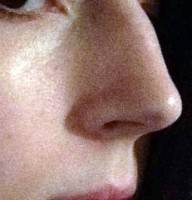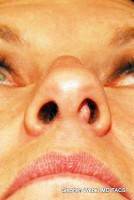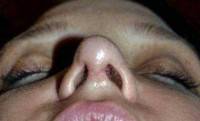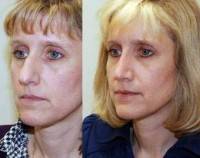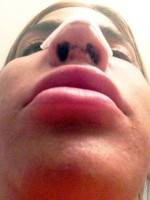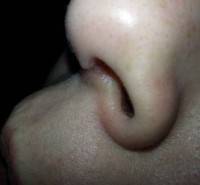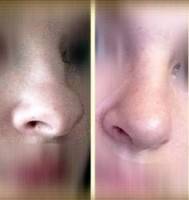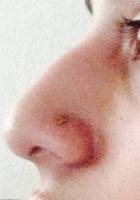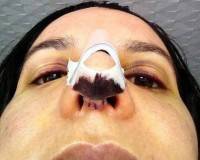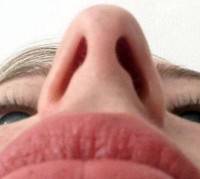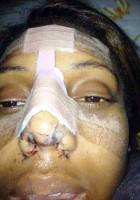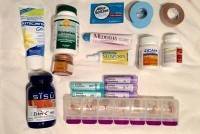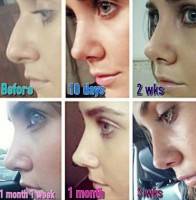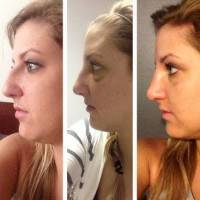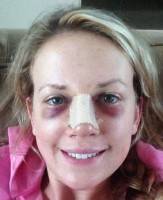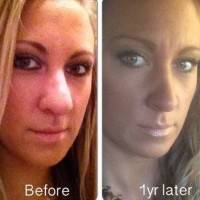Rhinoplasty Info
Rhinoplasty (nose job) information – is info about surgical procedure that changes the shape and size of the external nose and restores the function of nasal breathing.
The reason for correcting the shape of the external nose can be congenital or acquired (posttraumatic) deformation. During surgery the intervention will be made as on the bone, and on the cartilage of the nose.
The surgeon can remove the “hump” to narrow or align the back of the nose, lift, shorten and to narrow tip. Sometimes surgical intervention is necessary on the wings of the nose due to the asymmetry or excessive width of the base of the nose.
Quite often the deformation of the external nose is combined with dysfunction of nasal breathing due to the curvature of the nasal septum or increase (hypertrophy) of nasal turbinates.
In such cases rhinoplasty can be combined with surgery called septoplasty which may restore the function of nasal breathing. Rhinoplasty can be open and closed. There is also the term “non-surgical” rhinoplasty.
Open rhinoplasty information – the surgeon makes incisions in the columella (column) of the nose and in nasal cavity. The skin is separated from the skeleton of the nose and all stages of the surgery performed under visual control.
At the end of surgery the skin is closed with stitches, which are removed on the 5th day. Incisions in the nasal cavity sutured with absorbable yarns that do not require removal. A plaster cast is applied to the nose and the tampons are inserted into the nostril holes.
Closed rhinoplasty information – no cut on the skin. All the incisions are made in the nasal cavity and hidden from view. Most rhinoplasty steps are performed blindly, so because closed rhinoplasty is performed when need a small correction. At the end of surgery, the surgeon puts a plaster cast on the nose and insert tampons in nostril holes.
Non-surgical rhinoplasty information – change the shape and contours of the external nose by using various kinds of fillers or injections of fat (lipofilling). The most popular for contour plasty of the nose are fillers based on hyaluronic acid. This procedure does not require survey and hospital stay. Drugs are administered by injections under the skin of the nose.
Detailed information about the rhinoplasty surgery
Time of rhinoplasty surgery: 1-2 hours.
Anesthesia: General or local anesthesia
Place of surgery: In a hospital environment. The stay in the hospital about 1-3 days.
Possible side effects of rhinoplasty: Swelling, bruising around the eyes, minor bleeding in the early postoperative period. These effects disappear after a few days.
Rhinoplasty Risks: Infectious complications, the asymmetry of the nose, dissatisfaction of the form of the nose.
Rhinoplasty Recovery Info: After rhinoplasty special tampons are inserted in the nose, which are removed in 2-3 days. You need to wear a plaster cast round the clock a week after surgery. Then a plaster cast is worn for two weeks only for the night. You can get to work after 7 days. Physical activity can resume after 3 weeks. The closest result of rhinoplasty surgery is evaluated after 3 months. A final result is estimated after 1 year.
The result of rhinoplasty: Permanent.
By creating a new harmonious nose mandatory element of the work of the surgeon is maintaining or restoring of lost nasal breathing patient.
Reducing the nose in general, the width or projection of the nose always reduces the lumen of the nasal passages. But this does not mean that there will be reduced nasal breathing.
The most important structural elements that provide the respiratory function of the nose, is a nasal septum, external and internal nasal valves. When working with nasal septum surgeon is required to:
- Maintain or restore its supporting function. If the septal cartilage even strongly deformed or curved, but it is present, it is used as a plastic material. Thus it is removed from the nose is simulated, and then reimplanted and fixed to the remaining skeleton nose. In the absence (due to earlier made rhinoplasty) hard material used rib cartilage grafts. Ear grafts for these purposes are unsuitable due to their softness. Allografts are not used because of the risk of rejection;
- To eliminate any mechanical obstruction to air flow in the form of curves and fractures of the wall of cartilage, spikes, ridges. If necessary, produced curved osteotomy of the bone at the back of the nose septum;
- Maintain the integrity and intact of mucosa of the nasal passages as much as possible.
Two nasal valves (internal and external) are recreated by the surgeon with suture technology upon completion of the back of the nose. If the patient complains of a curved bridge of the nose, asymmetry of the tip, he may have a deviated septum. It is impossible to guarantee the smooth nose and satisfactory nasal breathing after the surgery without alignment the nasal septum.
The indications for rhinoplasty surgery
Most often want to make rhinoplasty patients with large or thickened tip, hump on back, curvature of back or nasal septum, large nostrils, a variety of post-traumatic or post-operative deformities. In some cases, the surgeon has difficulty to fully implement the wishes of the patient. In modern hospitals successfully carried out simultaneously as the surgery to change the appearance of the nose, and to restore nasal breathing, eliminating various reasons for its violation.
In the practice with a deficiency of plastic material the plastic surgeons use as an additional graft an ear and rib cartilage, especially when man is previously operated or repeatedly injured. At the consultation surgeon pronounces effects that the patient receives after surgery for each part of the nose (nasal bridge, wings, septum, the tip). Later, these moments are documented in the contract.
Rhinoplasty procedure
Surgery always goes under general anesthesia. The most common technique that used in clinics is open rhinoplasty. Incisions are made in the middle of columella of the nose (anterior column partitions) and inside it, and sometimes additionally under the wings at the base. After 3-4 weeks, they are almost invisible.
An obligatory element of the work is the quality of revision septum for resolving the issue of the respiratory function of the nose. In a hospital you should stay less than one day. The gauze turundas are set at 2-12 hours after surgery, then removed and do not change. The dressing from the terpolymer is applied at the end of surgery only on the nose and removed after 6-7 days (individually). Rarely used intranasal termosplints. The stitches are removed after 7 days partially. The remaining self absorbed.
Rhinoplasty recovery
Pain syndrome is not typical after surgery. Patients concerned about the violation of nasal breathing in the first few days after surgery due to swelling of the deep tissues and the presence of blood clots. The patient feels more comfortable in the presence of even a small air flow.
The first few days there is a sanies-mucous discharge from the nasal passages. A day later it significantly decreases. After surgery the edema develops in the eye sockets. Hematoma (bruising) are always present, but more often they are small. A week later, swelling and bruising is significantly reduced and the patient may soon appear in public. After removing the bandage from the terpolymer in a week after the surgery saved edema of back and nasal tip.
The last well is reduced in the next 2 weeks. Therefore, we recommend that patients have 2-3 weeks to recover to the active social life. Sunglasses are allowed to wear after 11-12 days. The final shape of the nose can be assessed after 6-12 months. Rhinoplasty is a complex surgery that carried out in different parts of the nose. But carrying out on modern technology, using a variety of transplants and last sutures allows you to make the image of the computer forecast a reality.
Possible complications of rhinoplasty
Any surgical procedure carries a certain amount of risk. Rhinoplasty is no exception in this regard. When the operation is performed by a qualified surgeon the complications are rare. However, due to specific features of the anatomical structure, wound healing, the general reaction of the organism to the surgery there is a possibility of complications, including infection, nosebleed, or a reaction to medications entered during anesthesia.
The patient may significantly reduce the risk of surgical intervention, if carefully will follow the recommendations of the surgeon before and after surgery. On average, 3 times out of 10, to achieve the desired result may require additional surgical intervention to correct minor residual deformation.
Rhinoplasty planning
The basis of success of the surgery is a mutual understanding between patient and surgeon. At the first consultation the surgeon should listen to the patient’s expectations and to discuss with him all the possible options for changing the shape of the nose, explaining that of the existing methods of rhinoplasty is most suitable in this case, and to assess the factors that may affect the outcome of the operation.
The choice will be determined by the following parameters:
- structure of bone and cartilage structures of the nose;
- thickness and skin condition;
- the type of person;
- age;
- the wishes of the patient.
Computer simulations performed by the surgeon prior to surgery. The aim of this study is to simulate the shape of the nose using a special computer program. The surgeon selects the type and method of surgery, taking into account the expected result. Also, the doctor should be carefully collect history.
Preparing for rhinoplasty
The surgeon should explain to the patient how to prepare for surgery, including the principles of rational food intake and liquid, smoking, as well as receiving various drugs. If a patient has recently suffered upper respiratory tract infection or any infection of the skin, it is better to postpone the operation for a while. You must stop taking all products containing salicylates – preferably 10 days before planned surgery. The most frequently used tools – is aspirin, bufferan, alka-seltzer and others.
Women taking contraceptives or other hormones (e.g. estrogen replacement therapy) are more likely to bleed. Therefore, it is advisable to stop taking hormonal drugs for 10-14 days before surgery, and are not recommended to perform the surgery in the days of menstruation. With rhinoplasty can be used by different types of anesthesia, which are determined by the volume of surgery, the wishes of the patient and the surgeon’s preference. It is preferred to perform the surgery under general anesthesia, especially for intervention on the bone structure of the nose. In this case, during the surgery the patient will be spared from unnecessary emotional problems.
Rhinoplasty surgery information
The choice of surgical approach depends on the type of deformation of the external nose, as well as the preference of the surgeon. There are two options: the first – outside – the cut is carried out in the area of the skin of the nasal septum, the second – internal – cut extends from the nasal mucosa. There is no doubt that from an aesthetic point of view the most favorable is closed method that does not leave visible scars on face. However, it requires a certain experience of the surgeon, since surgery is performed almost blindly.
Rhinoplasty usually takes one or two hours. The volume of surgery depends on the original shape of the nose, as well as methods of surgery chosen by the surgeon. In the first stage of any rhinoplasty the surgeon makes the incision of the nasal mucosa. Then the surgeon proceeds to the correction the end of the nose. In some cases you may need to change the width and height of the base of the nose nostrils.
After removing the hump final contour of the nasal bridge can be formed using its own (removed during correction the end of the nose) or canned cartilage. For some patients shows for changing the contour of the nose the introduction of additional supporting tissues. Deformations of the nose of various origins, usually accompanied by a change in position of the nasal septum. Therefore, intervention on the internal structure plays an important role in the restoration of nasal breathing function and is one of the tasks in carrying out any of rhinoplasty.
After surgery a bandage is applied to maintain the shape of modeled nose. In the nasal cavity through each nostril entered gauze pads which create internal support tissues of the nose. It should be remembered that the nose created on the operating table in the future is changing, that the surgeon can not predict with mathematical precision. This process will depend on the individual characteristics of healing and skin thickness, a tendency to scarring, and many other factors.
Usually after the surgery does not appear any pain, but it may be a slight malaise and headache, which are reduced to a minimum after taking pain medication prescribed by your doctor. Immobilizing cast is removed 5-6 days after surgery, turundy retrieved after 1-3 days. After open rhinoplasty, as well as with changing the position of the wings of the nose, stitches are removed in 1-2 days after surgery, and then the edge of the cut is fixed with special glue for optimum healing and the formation of undetectable scar. Gluing removed approximately after 5-7 days. In a closed rhinoplasty (where incisions are made in the nasal cavity) stitches dissolve on their own.
Recovery time after rhinoplasty surgery
In the early days the swellings and bruising in the periorbital area may be increased, but starting from 3-4 days they will be gradually reduced and will soon disappear without a trace. After 1-2 weeks the nose will get a perfectly acceptable appearance.
However, the final form will appear in 6-12 months after surgery. It should refrain from physical activity (including various sports) within 2 to 3 months after surgery. Be especially careful in the care of the skin around the nose, since after the operation it will be susceptible to various injuries. It is advisable to abandon the mechanical cleaning of the face, and not to go to the bath or sauna for several months. After removing the bandage you can’t wear glasses for 6-7 weeks. If necessary, possible to use contact lenses.
Healing is a gradual process. The patient will see change in shape of the nose immediately after surgery, but the final result will be much later. Every day, your nose will look better and better. After a week or two, the patient will return to a normal life, but with some restrictions. The patient should visit the doctor at the scheduled time, so that he could follow the process of healing. At occurrence any unusual sensations in any period of time after the surgery the patient should inform to his surgeon.
Rhinoplasty info:
- Rhinoplasty Nostrils Different Sizes Rhinoplasty nostrils is plastic surgery, which allows to eliminate the asymmetry of the nostrils, correct the width, length and thickness of the wings of the nose. A short operation not only will save you from...read more
- Persian Nose Job Persian nose job is a difficult task even for an experienced surgeon. Persian nose is the exact opposite of the Caucasian nose. Persian nose is typical low bridge, which makes the nose “low”, and wide...read more
- Phymatous Rosacea Phymatous rosacea: skin thickening, increased nose and surrounding tissues. The most common subtype is called rhinophyma,which affects the sebaceous glands and outer side of the nose and causes an increase in the nose and has...read more
- Fixing a Deviated Septum Nasal septum is a wall made up of bones and cartilage that separates the inner nasal cavity into two passage. Thus, it plays an important role in controlling the flow of air entering the body....read more
- Nose Bump Surgery How many people are unhappy with their nose? There are no precise statistics on this issue. But there are statistics of popularity of plastic surgery, in which rhinoplasty traditionally occupies one of the first places....read more
- Radiesse Nose Job Every second person on this planet thinks about the shape nose correction. But few are resolved to the radical correction, as surgical rhinoplasty is a radical way, after the application of which way back will...read more
- Nasal Hump Removal Nasal Hump Removal is the most common operation in cosmetic surgery aimed at changing the shape of the nose. Surgery is performed between the ages of 20 to 40 years. The price depends on the...read more
- Rhinoplasty Night Before Surgery Night before the rhinoplasty is very thrilling. Here are some tips how to spend the night before rhinoplasty. Food intakes If your rhinoplasty is scheduled for 08:00 am, you should not eat or drink water...read more
- Nose Bridge Augmentation Nose bridge augmentation is a surgical procedure, which can be used to change the size of the nose entirely or increase its individual parts. Many people are not satisfied with the shape of their nose....read more
- Septoplasty And Turbinectomy According to medical statistics, a deviated septum in varying degrees, is seen in about 80% of people. It is not always such a deformation creates discomfort to man, but when it does occur may require...read more
- Septorhinoplasty Aftercare In most cases pains are poorly expressed after septorhinoplasty, but often there is a general weakness, increase in temperature maybe a little bleeding from the nasal passages. The main discomfort is observed in the first...read more
- Aquiline Nose Job Aquiline nose can be a highlight of your face. But not everyone can love this highlight. What to do? To resort to plastic surgery and “to break” the nose? No, there is a way. Straight...read more
- Rhinoplasty Cast Removal As is known, the majority of plastic surgeries on the face relate to changes in shape of the nose. In this article, we describe how is the post-operative period, namely is rhinoplasty cast removal, what...read more
- Rhinoplasty Aftercare Instructions The human body needs to recover from any surgery. The very essence of rhinoplasty involves damage to the soft tissues of the nose, as well as cartilage and bone skeleton as a result of corrective...read more
- Everything You Need To know About Rhinoplasty The most popular procedure in cosmetic surgery is considered to be operations involving aesthetic correction of the form of nose. That is rhinoplasty. Sometimes rhinoplasty is performed for medical reasons. For example, in the case...read more
